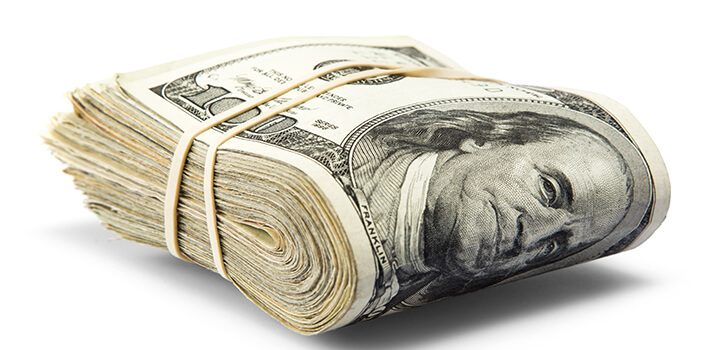Saving and investing are two entirely different things. Generally, “saving” means depositing cash into a traditional savings account or a money market account. You earn a little bit of interest and the money is easily accessible so you can tap it when you need to.
Investing is an entirely different ballgame. Saving is generally a short-term strategy; investing focuses on long-term goals.
“When consumers invest, they are hoping for growth, income, or both,” says Keith Klein of Turning Pointe Wealth Management. Generally speaking, you use your money to purchase assets that you expect to appreciate over time. In other words, you buy something at one price in the hopes that when you decide to sell it the asset will be worth more than what you paid, or that the asset will earn dividends while you own it.
Many investors choose to put their money into stocks. While stocks have the potential offer high returns, the downside is that they are a volatile investment. That means investors lose money if the stock doesn’t perform well, and it happens all the time.
If you’re ready to get a little more juice out of your savings than the interest rate you’re getting at the bank, look at the alternatives that pose less of a threat to your bottom line. These four options are good for beginners who are new to investing.
1. Certificates of deposit
A certificate of deposit or CD is designed to offer you a higher interest rate than a regular savings account without putting your money at risk. Here’s how they work.
You deposit your savings into a CD for a set period of time. In general, CD terms range from three months to five years, but they can go longer. While you hold the CD, your money earns interest. Once the CD comes to the end of its term, you’ve got two choices. You can either withdraw your initial investment, along with the interest, or reinvest it for a new term.
CDs offered by FDIC or NCUA insured institutions (banks and credit unions) are safe deposits. The annual percentage yield (which is the annualized amount of interest you can earn on a deposit), is usually higher than what you can earn with a traditional savings account. For example, the bank may offer 0.1% (one tenth of one percent) APY for savings or 1.25% APY for a 3-year CD. A longer maturity term typically means a higher APY.
So how does that add up? Consider this example. Assume you put $5,000 into a 3-year CD with a 1.25% APY. Once the term is up, your balance will be $5,191.06 (with interest compounded daily). In a savings account at 0.1%, your balance after three years would be $5,015.02.
While CDs can provide safe earnings, they do come with downsides. If you decide to cash out your CD before it hits the maturity date, you’ll likely face a penalty. Depending on the bank, you may have to pay a fee or forfeit some of the interest you’ve earned for withdrawing your investment ahead of schedule.
The other major downside is that the interest you earn on a CD may fall short of the rate of inflation. The longer the term, the more significant this risk.
2. Bonds and T-bills
Bonds and T-bills (Treasury bills) are debt securities. When you invest in a bond or a T-bill, you loan money to a government entity for a specific amount of time.
Bonds can have short or long maturity terms, with some extending up to 30 years and longer. T-bills can be issued with maturity terms of just a few days, or up to 52 weeks. The most common T-bills are issued on one-, three- and six-month terms. When the term ends, the issuer pays the investor the face value of the bond or T-bill, plus interest. Like CDs, the longer the term, the higher the yield.
The advantage to these investments is that they’re exceptionally safe. Government-issued bonds and T-bills are backed by the full faith and credit of the government that issues them. You’re virtually guaranteed to recover what you’ve invested, along with the interest.
Treasury bills in general tend to be more liquid than a CD, which is good if you’d like the flexibility of being able to convert your investment to cash without a penalty. Another difference is that bonds and T-bills aren’t technically deposit accounts so they aren’t covered by the Federal Deposit Insurance Corporation (FDIC). The FDIC would cover a CD, up to a certain amount, if your bank were to go under.
Bonds and T-bills fall short of what stocks can deliver. Historically, the S&P 500 has generated an average annual return of 11.41% between 1928 and 2015. By comparison, three-month Treasury bills yielded an annual return of 3.49% over that same period. The 10-year Treasury bond returned an average of 5.23%. Keep in mind that returns aren’t guaranteed.
3. Mutual funds
A mutual fund is like a basket of investments. Inside the mutual fund is a mix of stocks, bonds, money market funds and other assets. When you buy shares of a mutual fund, you’re spreading your money across all of those different investments.
Investing in mutual funds allows you to diversify your portfolio. Your portfolio is all the investments you hold. Diversification is important because it helps you to minimize risk. If one of the stocks in the mutual fund loses value, for example, the loss can be offset by gains in the other investments in the fund.
An important consideration when evaluating mutual funds is cost. Broadly speaking, mutual funds can be actively or passively managed. An actively managed fund has a fund advisor who makes investment decisions. The fund manager decides which investments to buy and which ones to sell in order to meet performance goals.
A passively managed fund has investments that are chosen automatically. Passively managed funds often track a stock index, like the S&P 500 or the Dow Jones Industrial Average. The investment picks for the fund are based on trends in the underlying index.
The advantage of choosing passively managed funds is that they’re usually cheaper than actively managed funds. Mutual funds have a built-in expense ratio, which is the percentage of your assets that are deducted each year to cover the cost of maintaining the fund. The higher this ratio, the greater the cost to you.
Passively managed funds may have an expense ratio of 0.25% or less while actively managed funds can easily cost 1% or more in fees. Here’s another example to give you an idea of just how expensive the fees can be.
Let’s say you invest $10,000 in two different mutual funds. Fund A, which is passively managed, has an expense ratio of 0.20% while the actively managed Fund B’s expense ratio is 0.75%. If you invest an additional $5,000 per year for 30 years, you’ll pay about $17,000 in fees for Fund A, assuming a 6% annual return. Fund B, on the other hand, costs close to $60,000 in fees.
Because mutual funds include stocks, they are riskier than CDs, bonds or T-bills. Risk tolerance is a personal decision. Generally speaking, the farther you are from retirement, the more risk you can comfortably take on. If you’re investing in your 20s, you’ve got a fairly long time ahead of you and a greater likelihood of seeing good average annual returns.
4. Exchange-traded funds

An exchange-traded fund or ETF is a type of mutual fund that has similarities to a stock. Stocks can be traded back and forth as long as the market is open. Mutual fund trades are made once a day at the market’s close. An ETF gives you the best of both worlds because you can trade it just like you would a stock.
The price of an ETF can go up or down during trading hours. ETFs can be actively or passively managed and they operate with the same kind of fee structure as any other mutual fund. Passively managed funds can be cheaper. That’s a plus if you don’t have a lot to invest and you want to stretch every dollar as far as possible.
Something else that sets exchange-traded funds apart is their tax efficiency. Typically, mutual funds are more likely to pass capital gains tax liability on to their investors on a regular basis.
Exchange-traded funds have lower turnover, meaning assets in the fund aren’t bought and sold as frequently as they are in some other types of funds. If you hold on to an ETF for a year or longer, you won’t pay capital gains tax until you decide to sell the fund. Then, you’ll pay the long-term capital gains rate. “Capital gains can be as high as 20% if you’re in the highest tax bracket, and your overall liability can be higher when you consider additional taxes for high earners,” says Klein.
Again, the risk level with exchange-traded funds is higher than the risk associated with a CD or bond. If the stocks included in the fund go down in price, the value of your shares also goes down.
One advantage to ETFs is that they are a more convenient way to invest if you don’t have a lot of cash. Some mutual funds require a minimum deposit of several thousand dollars. With an ETF, all you need is enough money to purchase a single share (plus commissions and fees).
Is robo-investing a good choice for newbie investors?

Robo-investing is a relatively new trend but it’s caught on in a big way. Robo-advisors use an algorithm to analyze your portfolio and risk tolerance, then make investment decisions for you.
Generally, robo-advisors allow you to invest in exchange-traded funds. This preference goes back to their tax efficiency and lower cost. Robo-advisors often feature multiple ETF portfolios you can choose from, based on the level of risk you’re comfortable with.
If you’re not sure how to get started picking investments, robo-advisors take some of the hassle out of the process. You answer a questionnaire and the advisor creates an investment recommendation based on your answers. You don’t really have to do much from that point forward, assuming you like the funds that have been chosen for you.
Not all robo-advisors are created equally. Some, for example, automatically rebalance your portfolio. Others help with tax loss harvesting.
Rebalancing means shuffling your investments to keep them in line with your risk tolerance.
Tax loss harvesting helps maximize the tax efficiency of your investments. When you “harvest” a loss, you sell off an asset that’s losing money and replace it with one that’s similar but not identical. Having a robo-advisor do this for you can take a lot of the guesswork out of managing your portfolio.
A significant feature of robo-advisors is the lack of personalization. This can be seen as an advantage or a disadvantage. When you work directly with a broker or a financial advisor, you get human input on your investment choices. With a robo-advisor, the human element is taken out of the equation.
Investment and risk
As a general rule, the more risk you assume, the more you stand to gain. And the more you stand to lose if the investment falters. Seek advice from a licensed financial professional. If you work for a company that offers retirement accounts, you might have access to a financial advisor for free. Even if you don’t, it’s a good idea to find a person in the know who can explain the pros and cons of your options and help create a long-term strategy that works for you.
























